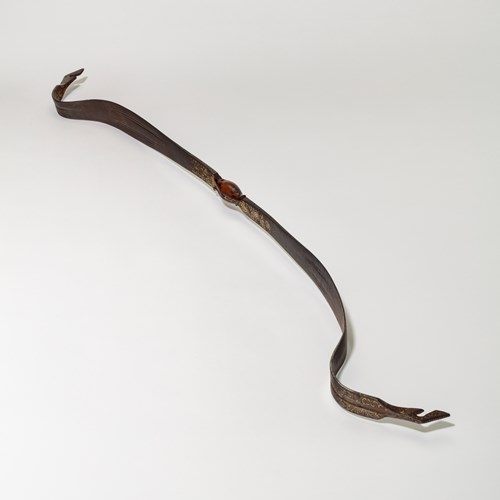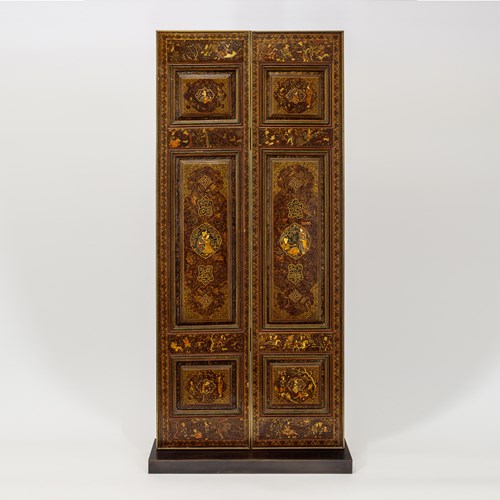Marketplace
Safavid Divination Bowl
Astrology was considered an important scientific discipline in the Islamic world. Medieval Islamic thinkers conceived of the universe as a series of concentric circles (aflāk), whose movements within and around each other affected events on earth.1 The importance of the celestial bodies was derived from their distance from earth. The first seven spheres belong to the seven known planets, namely the Moon (al-qamar), Mercury (‘uṭārid), Venus (al-zuhara), the Sun (al-shams), Mars (al-mirrīkh), Jupiter (al-mushtarī), and Saturn (zuḥal). The eighth sphere is that of the Fixed Stars, including the twelve constellations of the Zodiac.2 The importance of the influence of the planets was such that decorating objects with cosmological symbols was believed to imbue them with healing properties. This power, combined with qur’anic verses, could be activated by means of contact with liquid, which could be consumed by an individual seeking protection or cure.3 Bowls of this type were manufactured throughout the Islamic world, however, several references to Kashan in inscriptions on Persian bowls suggests this to be a primary centre of manufacture in Iran by the mid 16th century.4
This brass talismanic bowl sits on a low ring-foot and has a slightly everted rim. It has a raised central boss which may derive from the Graeco-Roman omphalos or umbo of libation bowls.5 Every surface is covered with engraved decoration relating to astrology, with remaining space filled with qur’anic inscriptions in ‘dust-like’ ghubari script. Bands of thuluth inscription run at the top and bottom of the outside of the bowl. The lower register includes the date of 1053 (equivalent to 1643-1644 CE) and can be found directly below the Pisces medallion.
The outside of the bowl features a band of connecting six-pointed stars, each enclosing a representation of one of the twelve signs of the zodiac. Some of these signs are represented traditionally, but others are more idiosyncratic to Persian design. Leo, for example, is portrayed as lion with a rising sun behind. This figure resembles Shir o Khorsid, an emblem of Iran and formerly an element in the national flag. The representation of Virgo (al-sunbula) is radically different from its Western iconography, shown as a figure reaping corn with a scythe. The representation derives from the fact that the name of the constellation, al’adhrā (the virgin) was not passed onto the name of the Zodiac sign, which was named after the brightest star in the constellation, sunbula, which means 'ear of corn'.6
The raised boss features a 12-pointed star, a number which figures throughout the design of the bowl. Not only are there 12 signs in the zodiac, but there are also 12 Imams in Shiite Islam. Around the central boss are anthropomorphised representations of the planets: Mercury ‘the Scribe’ is depicted as a young man writing on a scroll of paper; Venus as a female musician; Mars as a warrior, bearing a sword and severed head of his enemy; Jupiter as a judge; with a long beard.7 The sun and the moon are represented as celestial bodies, with faces added. On the foot is a 4 x 4 magic square. The top row of the magic square is formed of four cells containing words. When the numerical value of each letter is substituted for the letter itself (following the abjad alphanumeric system), the columns, rows, and diagonals add up to the same sum.
Further examples of Safavid brass divination bowls which date to the mid-17th century can be found in the Ashmolean Museum, Oxford (accession no. EA1992.51); the Hermitage Museum, St Petersburg (inventory nos VC-42, VC-206, VC-203, VC-204). Two very similar bowls which have been listed as 16th century, but are not dated, and bear great resemblance to the current example, are found in the Brooklyn Museum, New York (accession no. 1989.149.7) and the Saint Louis Art Museum, Missouri (accession no. 262:1915).
n.b. accession nos are clickable links
1 Lory, Pierre. ‘Divination and Religion in Islamic Medieval Culture’ in Francesca Leoni (ed.) Power and Protection: Islamic Art and the Supernatural. Oxford: Ashmolean Museum, 2016. 13-13: 13.
2 Carboni, Stefano. Following the Stars: Images of the Zodiac in Islamic Art. New York: The Metropolitan Museum of Art, 1997. 3.
3 Gruber, Christiane. ‘From Prayer to Protection: Amulets and Talismans in the Islamic World’ in Francesca Leoni (ed.) Power and Protection: Islamic Art and the Supernatural. Oxford: Ashmolean Museum, 2016. 33-52: 33.
4 Savage-Smith, E. ‘Safavid Magic Bowls’, in Jon Thompson and Sheila R. Canby (eds) Hunt for Paradise: Court Arts of Safavid Iran. Milan: Skira, 2003. 240-247: 246.
5 Allan, James W. Metalwork of the Islamic World: The Aron Collection. London: 1986. 42-47.
6 Carboni. Op. Cit. 35.
7 Ibid. 6.
This brass talismanic bowl sits on a low ring-foot and has a slightly everted rim. It has a raised central boss which may derive from the Graeco-Roman omphalos or umbo of libation bowls.5 Every surface is covered with engraved decoration relating to astrology, with remaining space filled with qur’anic inscriptions in ‘dust-like’ ghubari script. Bands of thuluth inscription run at the top and bottom of the outside of the bowl. The lower register includes the date of 1053 (equivalent to 1643-1644 CE) and can be found directly below the Pisces medallion.
The outside of the bowl features a band of connecting six-pointed stars, each enclosing a representation of one of the twelve signs of the zodiac. Some of these signs are represented traditionally, but others are more idiosyncratic to Persian design. Leo, for example, is portrayed as lion with a rising sun behind. This figure resembles Shir o Khorsid, an emblem of Iran and formerly an element in the national flag. The representation of Virgo (al-sunbula) is radically different from its Western iconography, shown as a figure reaping corn with a scythe. The representation derives from the fact that the name of the constellation, al’adhrā (the virgin) was not passed onto the name of the Zodiac sign, which was named after the brightest star in the constellation, sunbula, which means 'ear of corn'.6
The raised boss features a 12-pointed star, a number which figures throughout the design of the bowl. Not only are there 12 signs in the zodiac, but there are also 12 Imams in Shiite Islam. Around the central boss are anthropomorphised representations of the planets: Mercury ‘the Scribe’ is depicted as a young man writing on a scroll of paper; Venus as a female musician; Mars as a warrior, bearing a sword and severed head of his enemy; Jupiter as a judge; with a long beard.7 The sun and the moon are represented as celestial bodies, with faces added. On the foot is a 4 x 4 magic square. The top row of the magic square is formed of four cells containing words. When the numerical value of each letter is substituted for the letter itself (following the abjad alphanumeric system), the columns, rows, and diagonals add up to the same sum.
Further examples of Safavid brass divination bowls which date to the mid-17th century can be found in the Ashmolean Museum, Oxford (accession no. EA1992.51); the Hermitage Museum, St Petersburg (inventory nos VC-42, VC-206, VC-203, VC-204). Two very similar bowls which have been listed as 16th century, but are not dated, and bear great resemblance to the current example, are found in the Brooklyn Museum, New York (accession no. 1989.149.7) and the Saint Louis Art Museum, Missouri (accession no. 262:1915).
n.b. accession nos are clickable links
1 Lory, Pierre. ‘Divination and Religion in Islamic Medieval Culture’ in Francesca Leoni (ed.) Power and Protection: Islamic Art and the Supernatural. Oxford: Ashmolean Museum, 2016. 13-13: 13.
2 Carboni, Stefano. Following the Stars: Images of the Zodiac in Islamic Art. New York: The Metropolitan Museum of Art, 1997. 3.
3 Gruber, Christiane. ‘From Prayer to Protection: Amulets and Talismans in the Islamic World’ in Francesca Leoni (ed.) Power and Protection: Islamic Art and the Supernatural. Oxford: Ashmolean Museum, 2016. 33-52: 33.
4 Savage-Smith, E. ‘Safavid Magic Bowls’, in Jon Thompson and Sheila R. Canby (eds) Hunt for Paradise: Court Arts of Safavid Iran. Milan: Skira, 2003. 240-247: 246.
5 Allan, James W. Metalwork of the Islamic World: The Aron Collection. London: 1986. 42-47.
6 Carboni. Op. Cit. 35.
7 Ibid. 6.
More artworks from the Gallery






 Flower (Small)_T638206163546444815.JPG?width=500&height=500&mode=pad&scale=both&qlt=90&format=jpg)


